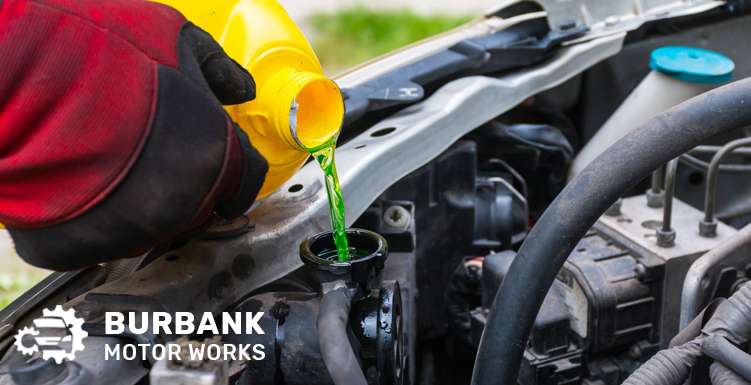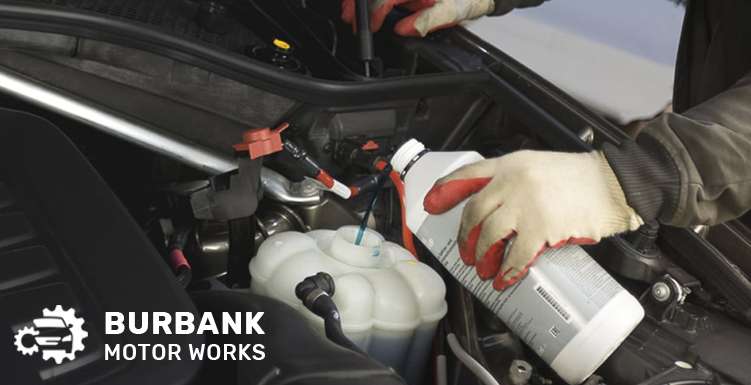
Address: 2208 W Burbank Blvd, Burbank, CA 91506

Mon - Fri: 7:45 Am - 5:30 Pm
Sat: 8:00 Am - 2:30 Pm
Sun: Closed

Address: 2208 W Burbank Blvd, Burbank, CA 91506

Mon - Fri: 7:45 Am - 5:30 Pm
Sat: 8:00 Am - 2:30 Pm
Sun: Closed
The cooling system is a very important part in the care of your car. A cooling system is very important for the longevity and better performance of the car’s engine. The coolant in your car not only prevents the engine from overheating, but also helps it run at the right temperature. Over time, the coolant loses its capacity and dirt also accumulates in it. In this guide, we’ll walk you through the eight important signs of a coolant flush in detail.

Constant increase in engine temperature is due to old or low coolant. The engine must work harder when the coolant does not work properly. Regularly watch for temperature signs on your car’s dashboard. High temperatures can damage many parts of the engine. Pay close attention to the engine temperature during summer. If the temperature indicator enters the red zone while driving, stop the car immediately.
Corrosion and crust accumulation in the cooling system is a sign of a serious problem. Chemical changes in old coolant can damage engine parts. The dirt accumulated in the tubes of the cooling system significantly reduces its functionality. It is necessary to clean the crust in the radiator with a special cleaner. Rusted parts should be repaired immediately. The accumulation of the crust slows down the flow of coolant.
The leakage of coolant indicates a problem in the cooling system. Old coolant becomes acidic which can damage seals and pipes. It is very important to check the traces of leaking coolant under your car regularly. The site of leakage should be found immediately and repaired. Leaking coolant can endanger other vehicles on the road. Leakage of coolant reduces the amount of coolant in the engine.
Steam coming out of the radiator is a sign that the coolant is not able to maintain normal temperature. The release of steam with the sweet smell of coolant can be a serious problem. This problem arises when the radiator cap is damaged or the coolant is low. The radiator cap should not be opened while steam is released. Hot coolant may cause burns. The radiator should only be checked after the engine has cooled down.
Strange sounds coming from the water pump are caused by old coolant. The dirt accumulated in the coolant can spoil the water pump quickly. It is important to get the car checked immediately after hearing strange sounds. The entire cooling system is affected by the malfunction of the water pump. Delaying repair of the pump can cause it to wear out completely. A faulty water pump stops the circulation of coolant.
Due to poor cooling, the engine starts using more fuel. High engine temperatures do not allow the fuel to burn completely. By keeping an eye on your car’s fuel consumption, you can detect the problem of coolant. Keep track of your car’s fuel consumption every month. The increased fuel consumption makes the maintenance of the car expensive. Timely checking of coolant saves fuel.
Cold air coming from the heater means that there is a blockage in the heater core. Flushing the coolant removes the blockage of the heater core. This will allow your car’s heater to work well again. The heater should be checked regularly in cold weather. Cleaning the heater core improves the flow of hot air into the car. A malfunctioning heater can cause snow to accumulate on car windows.
A change in the colour of a coolant is a sign of chemical reactions. It is very important to check the color and consistency of the coolant regularly. Getting the coolant flushed on time can save your car from serious damage. It should be replaced immediately if the green coolant is brown or black. Dirty coolant can damage cooling system parts. Keep checking regularly by remembering the color of the new coolant.

Coolant flush replaces old antifreeze as well as cleans up grime. This process gives your car several advantages:
Most car manufacturers recommend a coolant flush every 30,000 to 50,000 kilometers. Be sure to read the information given in your car’s manual book. Decide the time to change the coolant according to the age and weather of the car. Long-lasting coolant is used in the new model cars. Coolant can deteriorate quickly in hot areas. Regular coolant checks are required in old cars.
Ignoring signs of coolant flush can cause serious damage to your car. Pay attention to these eight signs and get your car checked regularly. Remember that the health of your car depends on your care. Regular maintenance of the car can avoid major repairs. Flushing coolant at the right time saves money. Never neglect the care of your car.
There are three main types of coolants – IAT, OAT and HOAT. The green IAT coolant needs to be changed every 30,000 kilometers. OAT and HOAT coolants can last up to 100,000 kilometers.
In a coolant change, only the old coolant is removed and the new one is filled. Complete cleaning is done in the coolant flush and rust and dirt are also cleaned by adding cleaner.
A coolant flush takes about an hour and a half. It takes time to remove the old coolant, clean the system and fill the new coolant.
The old coolant becomes acidic which can cause corrosion in the cooling system. Radiators, water pumps, and heater cores may be damaged. Dirt can accumulate in the engine, causing it to overheat.
Call us for booking an early appointment and get all your car related problems solved by our experts.